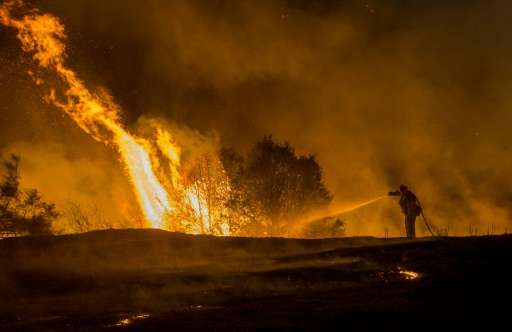Firefighter Joe Darr douses flames of the Rocky fire along Highway 20 near Clearlake, California, on August 2, 2015
Wildfires in the western United States have made 2015 the country's most devastating fire year since at least 1960, despite the relatively small number of individual fires.
More than 11 million acres (4.5 million hectares) have been burned in fires this year as of Friday, according to data from the National Interagency Fire Center.
That vast acreage—greater than the size of Denmark—is expected to rise over the remainder of the year, but it makes 2015 already the first year in at least five and a half decades to exceed 10 million acres burned, according to NIFC data.
That damage was done by 51,110 fires. By contrast, the last time US wildfires burned more than 9 million acres by October 8, in 2006, the number of fires totaled 84,578.
But NIFC data revealed a more worrying long-term trend: Since at least 1960 and up until the early 1980s, the US saw more than 100,000 individual wildfires each year, which, despite their numbers, never burned more than 5.5 million acres.
Between 2000 and 2014, however, the number of fires exceeded 90,000 only twice, but in nine of those years the total acreage burned exceeded 5.5 million.
That rise in more-damaging "mega-fires" has been widely attributed to fire management practices, a growing number of homes in or near major forests and, especially, a trend toward hotter, drier seasons.
Those effects may be most obvious this year, as fires have torn through drought-parched California and other western states.
The more than 11 million acres burned by just 51,110 wildfires so far this year means each fire burned on average 220 acres—more than twice the average acreage per fire through this point in the year over the past decade, according to an AFP analysis of NIFC data.
© 2015 AFP
























